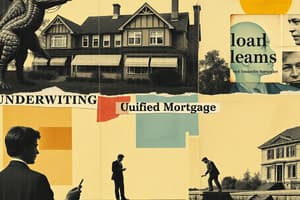Podcast
Questions and Answers
Underwriting is the process of evaluating a proposed loan.
Underwriting is the process of evaluating a proposed loan.
True (A)
Credit scores are examined during the underwriting process to determine credit worthiness.
Credit scores are examined during the underwriting process to determine credit worthiness.
True (A)
The quantity, quality, and durability of income are not usually analyzed when evaluating a buyer's application.
The quantity, quality, and durability of income are not usually analyzed when evaluating a buyer's application.
False (B)
Net worth is calculated by subtracting a person's liabilities from their assets.
Net worth is calculated by subtracting a person's liabilities from their assets.
Automated underwriting has completely replaced manual underwriting.
Automated underwriting has completely replaced manual underwriting.
What is the primary purpose of qualifying standards in lending?
What is the primary purpose of qualifying standards in lending?
Which entities are most likely to set the underwriting standards used by most lenders?
Which entities are most likely to set the underwriting standards used by most lenders?
What is the purpose of automated underwriting programs?
What is the purpose of automated underwriting programs?
What are the three main categories that determine creditworthiness?
What are the three main categories that determine creditworthiness?
How should weekly income payments be considered when qualifying a buyer?
How should weekly income payments be considered when qualifying a buyer?
What does a credit history primarily refer to?
What does a credit history primarily refer to?
What is the purpose of 'grossing up' non-taxable income during buyer qualification?
What is the purpose of 'grossing up' non-taxable income during buyer qualification?
What is the debt-to-income ratio?
What is the debt-to-income ratio?
Why might an underwriter be suspicious of recently opened accounts or higher-than-normal balances?
Why might an underwriter be suspicious of recently opened accounts or higher-than-normal balances?
The dependability of a borrower's income sources is best described as its:
The dependability of a borrower's income sources is best described as its:
If Theo receives $3,000 every two weeks, what is his approximate monthly income?
If Theo receives $3,000 every two weeks, what is his approximate monthly income?
What does a credit score primarily predict?
What does a credit score primarily predict?
What is the primary function of automated underwriting software?
What is the primary function of automated underwriting software?
What does an 'Accept' classification from an automated underwriting program typically signify?
What does an 'Accept' classification from an automated underwriting program typically signify?
What does a credit report include for an individual?
What does a credit report include for an individual?
Flashcards
Underwriting
Underwriting
The process of evaluating a proposed loan to determine if the buyer and property meet the lender's requirements.
Qualifying Standards
Qualifying Standards
Standards that reflect an underwriter's minimum requirements for a loan applicant's income, creditworthiness, and property.
Automated Underwriting
Automated Underwriting
A system that automatically analyzes loan applications based on set criteria, providing an initial assessment of risk.
Credit Reputation
Credit Reputation
Signup and view all the flashcards
Stable Monthly Income
Stable Monthly Income
Signup and view all the flashcards
Credit Score
Credit Score
Signup and view all the flashcards
Credit Report
Credit Report
Signup and view all the flashcards
Credit History
Credit History
Signup and view all the flashcards
Net Equity
Net Equity
Signup and view all the flashcards
Net Worth
Net Worth
Signup and view all the flashcards
Liens
Liens
Signup and view all the flashcards
Debt to Income Ratio
Debt to Income Ratio
Signup and view all the flashcards
Housing Expense to Income Ratio
Housing Expense to Income Ratio
Signup and view all the flashcards
Funds for Closing
Funds for Closing
Signup and view all the flashcards
Swing Loan
Swing Loan
Signup and view all the flashcards
Borrower's Financial Situation
Borrower's Financial Situation
Signup and view all the flashcards
Income
Income
Signup and view all the flashcards
Unacceptable Income
Unacceptable Income
Signup and view all the flashcards
Durability of Income
Durability of Income
Signup and view all the flashcards
Quality of Income
Quality of Income
Signup and view all the flashcards
Quantity of Income
Quantity of Income
Signup and view all the flashcards
Credit Report Derogatory Incidents
Credit Report Derogatory Incidents
Signup and view all the flashcards
Study Notes
Learning Objectives
- Students should be able to describe the basic steps in the underwriting process.
- Understand the goal of underwriting (qualifying) standards.
- Define different classifications in an automated underwriting report.
- Discuss an underwriter's considerations: credit reputation, income, and net worth.
- Define quantity, quality, and durability of income.
- List types of income that qualify as stable monthly income.
- Explain how to use income ratios to measure income adequacy.
- Calculate net worth using assets and liabilities.
- Understand credit history and credit scores.
- Explain other underwriting considerations, such as LTV, repayment period, and property type.
Suggested Lesson Plan
- Students should review the previous chapter, "The Financing Process," using Exercise 8.1.
- Provide an overview of Chapter 8, "Qualifying the Buyer," and review the learning objectives for the chapter.
The Underwriting Process
- The process of evaluating a proposed loan to ensure the buyer and property meet the lender's minimum standards.
- Qualifying standards are used to identify acceptable and unacceptable loan risks with secondary market considerations from Fannie Mae, Freddie Mac, FHA, or VA.
- Automation is used to analyze loan applications based on the performance of millions of existing mortgages to identify which factors increase or decrease the likelihood of default.
- Applications are classified as "Accept" to approve, or "Refer" for further review by an underwriter.
- The report also indicates the documentation required for further scrutiny or if an on-site appraisal isn't needed.
- Automated underwriting reports categorize risk, document required, and property appraisal needs.
- There are three main categories in underwriting recommendations: risk, documentation, and appraisal.
- Loan type affects risk assessment (e.g., an ARM is riskier than a fixed-rate loan).
- Owner-occupancy vs. Investor status: higher risk associated with an investor loan.
- Property type: certain properties may present higher risk due to factors like appreciation rate.
Evaluating Creditworthiness
- Creditworthiness is evaluated based on credit reputation, income, and net worth.
- Creditworthiness can be offset by strength in other factors.
- Credit reports: contain loans, purchases, and payment history for the past 7 years.
- Credit history refers to the length of time an individual has borrowed and repaid money.
- Credit scores: predict default risk based on past credit history, often based on FICO score.
- Major derogatory incidents (charge-offs, collections, repossessions, foreclosures, and bankruptcies) influence creditworthiness negatively.
- Credit reports may include information from three major credit reporting agencies: Equifax, Experian, and TransUnion.
Income Analysis
- Income is evaluated for quantity, quality (dependability), and durability (likelihood of continuation).
- Stable monthly income: income meeting quality and durability tests.
- Income sources: self-employment income, commissions, overtime, bonuses, retirement income (pension/social security), alimony/child support are generally considered dependable; temporary employment, unemployment benefits, and income from family members without obligation are not.
- Income ratios: measure the proposed monthly mortgage payment and installment debt against pre-tax income.
- Housing expense ratio: measures proposed monthly mortgage payment against pre-tax income.
- Child support, if paid consistently is accounted for in determining income.
- Non-taxable income may be "grossed up" because it is assumed the income will be taxed, increasing the likelihood of payment.
Net Worth
- Funds required to cover down payment, closing costs, and other related expenses.
- Liquidity is necessary after down payment, for up to 3 months' worth of monthly expenses.
- Assets: include funds for closing, savings accounts, retirement accounts, and other property such as automobiles, furniture, and real estate.
- Liabilities: include debts like credit cards, student loans, car loans, unpaid taxes.
- Gift funds can be used, if given and not obligated to be repaid.
- Delayed financing: financing may be obtained after closing.
- Net equity refers to the difference between the market value of a property and the total liens against the property.
Studying That Suits You
Use AI to generate personalized quizzes and flashcards to suit your learning preferences.




